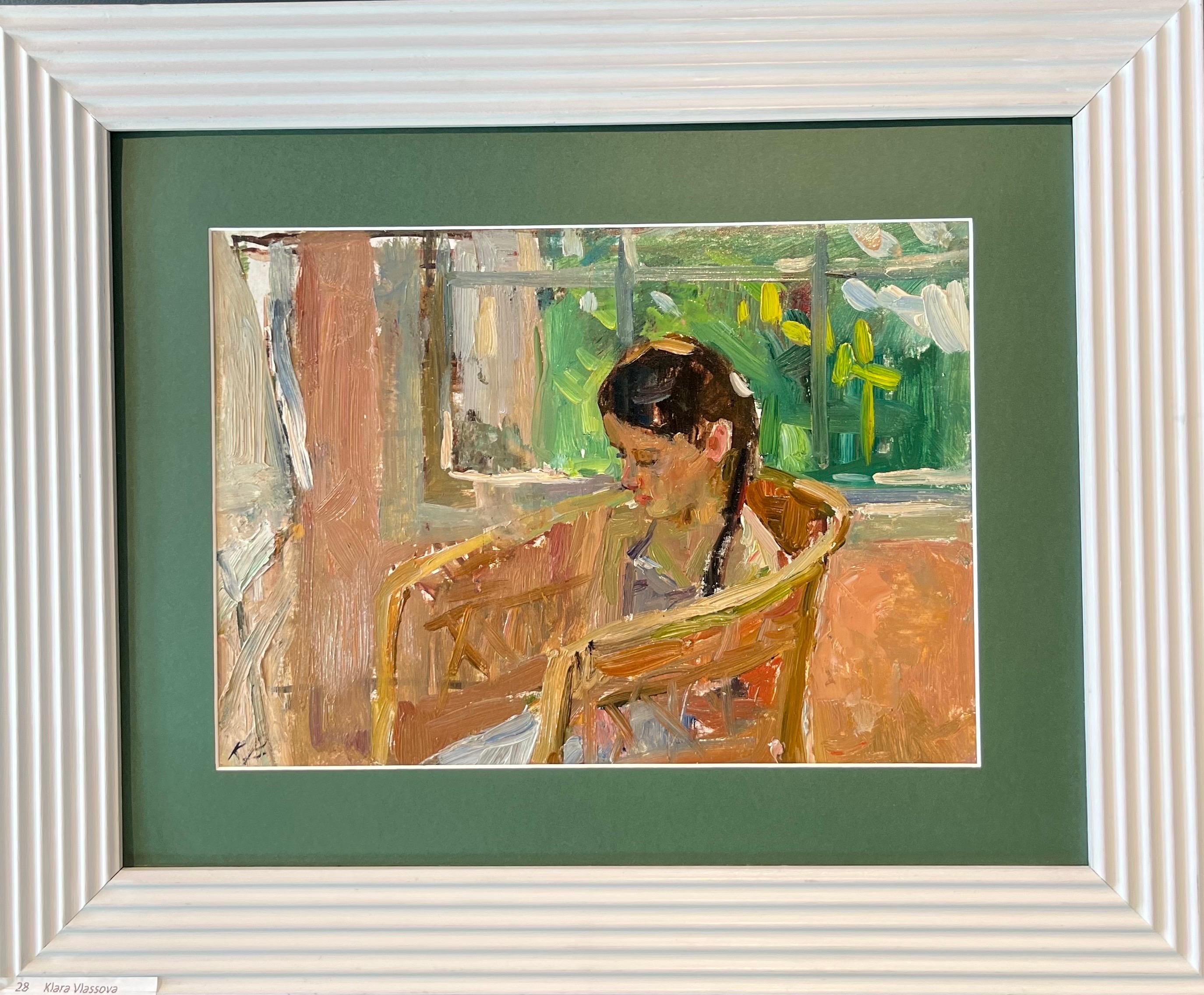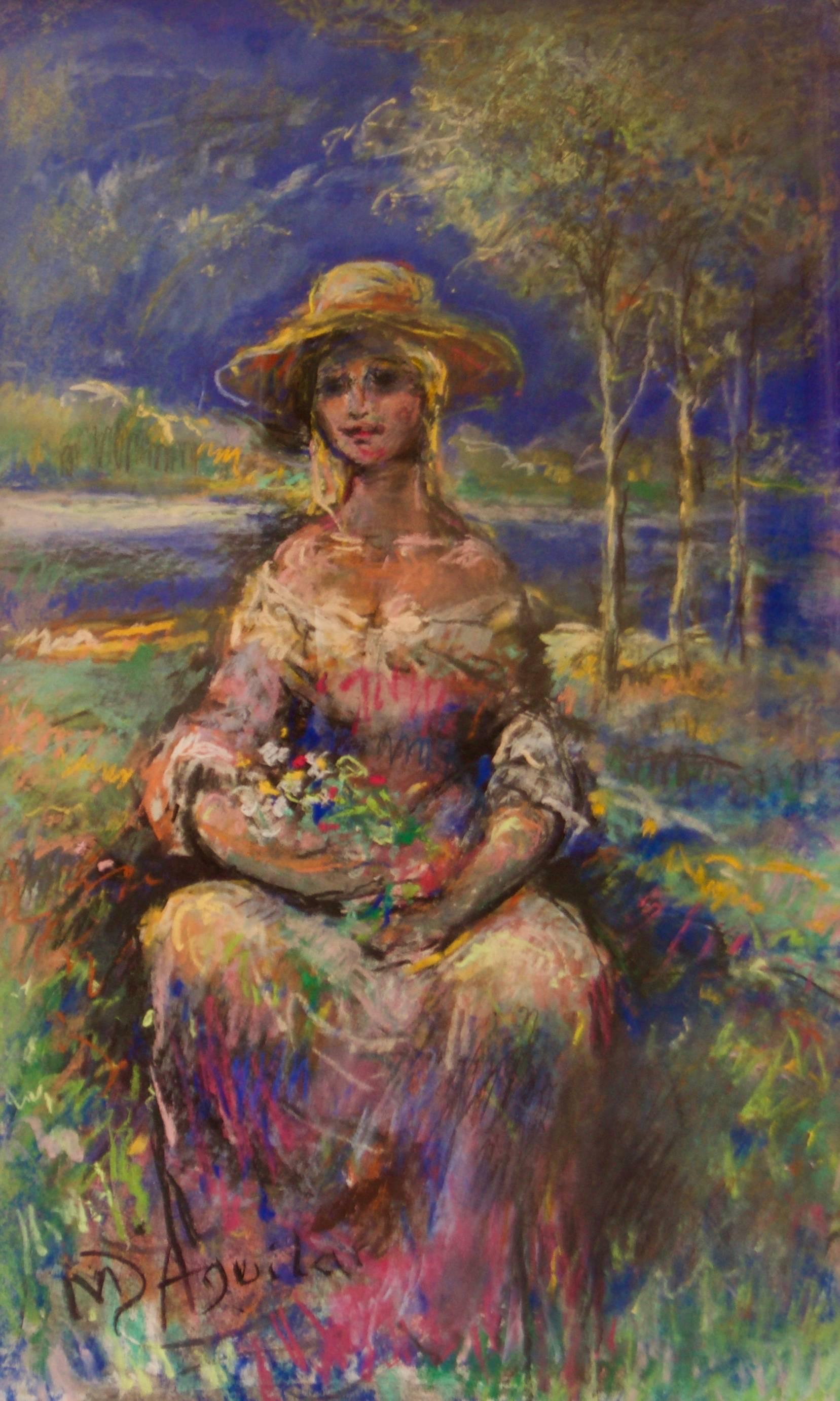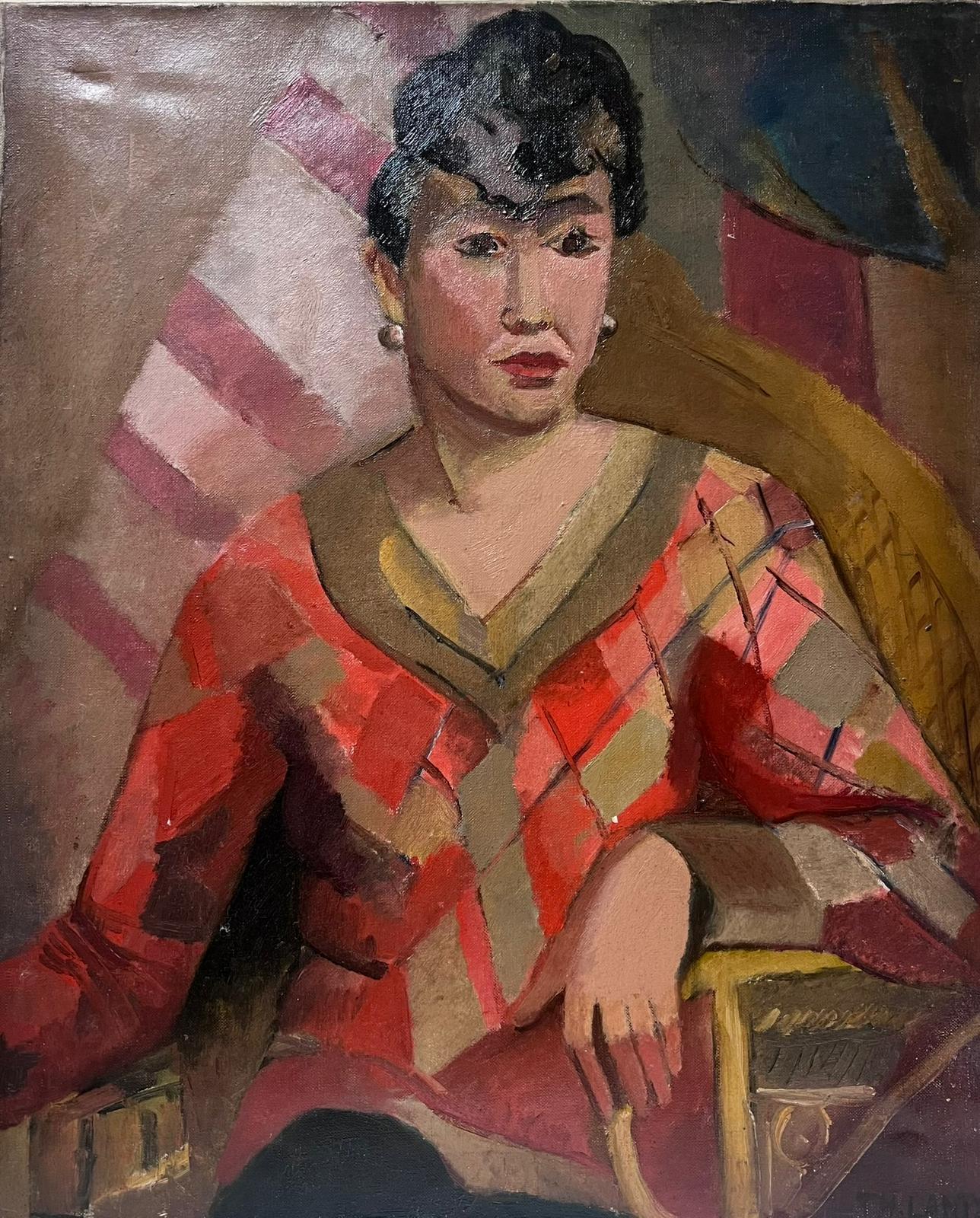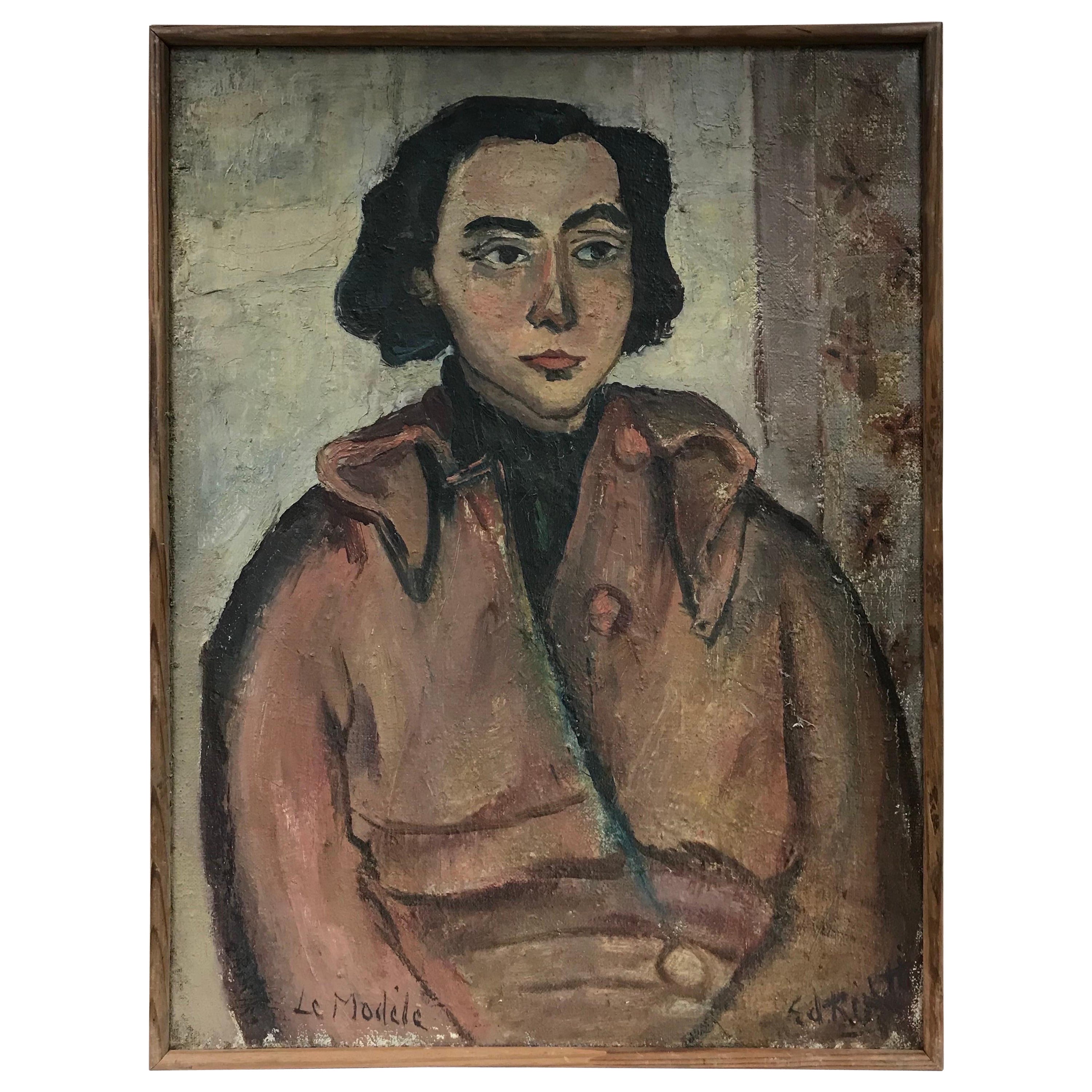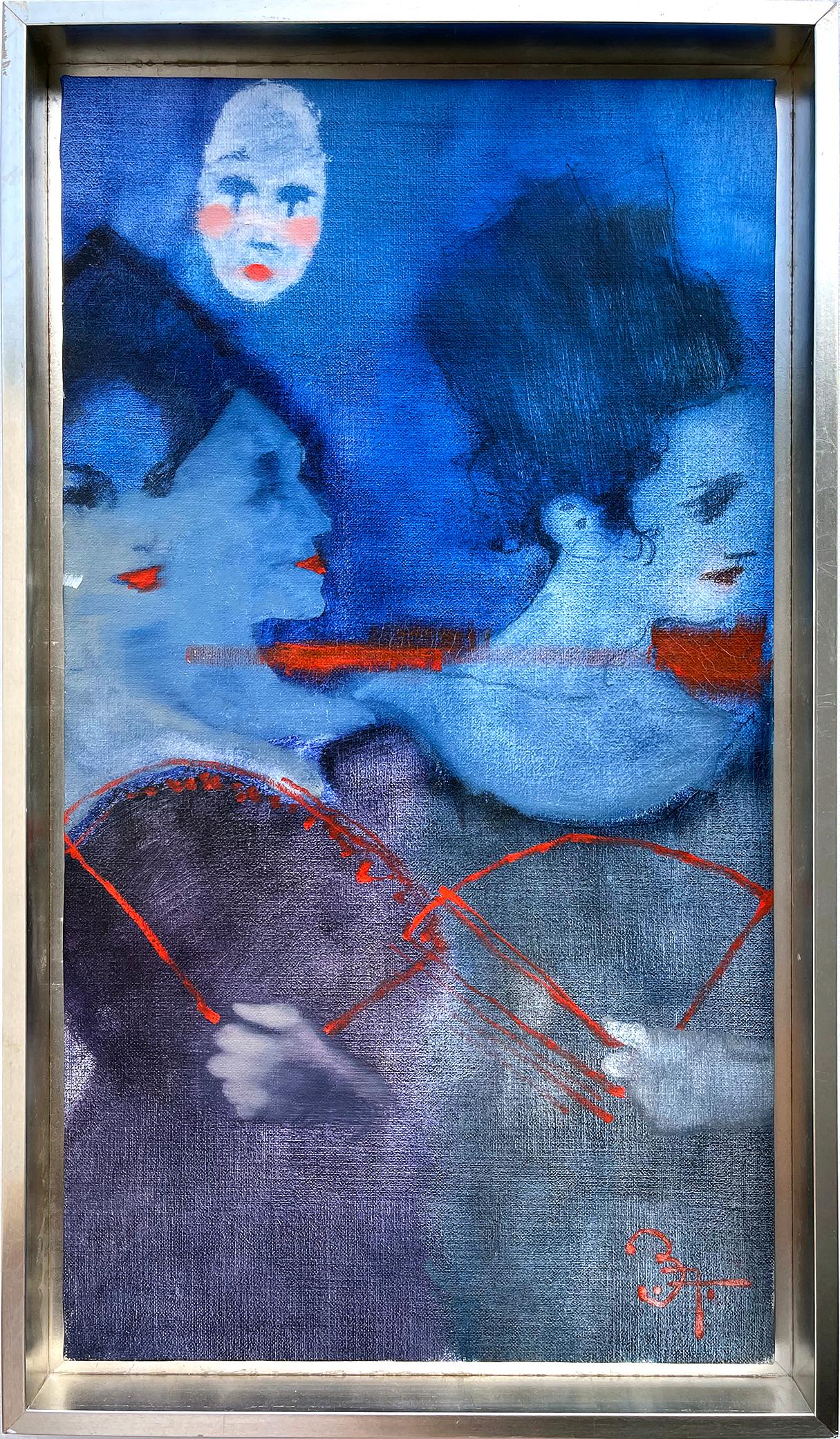Items Similar to Portrait of Water Bearers, Africa - British 1920's Orientalist art oil painting
Want more images or videos?
Request additional images or videos from the seller
1 of 15
Gerald Spencer PrysePortrait of Water Bearers, Africa - British 1920's Orientalist art oil paintingCirca 1925
Circa 1925
About the Item
This superb vibrant Orientalist Post Impressionist oil painting is by noted British artist Gerald Spencer Pryse. It was painted about 1925 when Pryse was visiting Morocco and Northern Africa. The painting depicts three women carrying water in vessels on their heads and dressed from the waist downwards in colourful cloth. Painted from a low vantage point, the women tower in the foreground. Beyond them are more figures in white or dark clothing, all beneath a clear blue sky. The vibrancy of the clothing and the pinks on white is tremendous. A really superb example of Pryse's time in North Africa and of his ability to perfectly capture the scenes he saw around him.
Provenance: From the artist's estate.
Condition. Oil on canvas, 30 inches by 25 inches and in good condition.
Frame. Housed in a complementary frame, 37 inches by 32 inches and in good condition.
Gerald Spencer Pryse (1882–1956) was a British artist and lithographer. Born at Ashton, Pryse studied in London and Paris, and first won a prize at the Venice International Exhibition in 1907. In the same year, he joined the Fabian Society, and helped to found The Neolith, a periodical of literature and the fine arts; the journal was printed in lithography. He was a regular exhibitor at the Senefelder Club, and contributed works to Punch, the Strand Magazine, and The Graphic. During the Great War, Pryse produced a considerable body of lithographic work, some of it in colour under the title Autumn Campaign (1914). This was based on his time in France and Belgium at the beginning of the war when he drove around in a Mercedes carrying lithographic stones in the back. He served as a dispatch rider for the Belgian government and was present at the Siege of Antwerp. The artist wrote a memoir of this time entitled Four Days: an account of a journey in France made between 28 and 31 August 1914, published by John Lane in 1932. Pryse also saw some of the Battle of the Marne and the Aisne but was back in Belgium to record the fall of Ostend and the subsequent retirement along the River Yser. Pryse also worked with the Indian Army in France and several of his lithographs depict scenes of Indian troops. Later, he served as a captain in the Queen Victoria's Rifles, King's Royal Rifle Corps, and was mentioned in dispatches. His main action was in the Third Battle of Ypres where he won the Military Cross, the 1914 Star, the Order of the Crown of Belgium, the Croix de Guerre. By the end of 1916, Pryse had made an application to become a war artist, and towards the end of the war, was granted permission to sketch at the front and he was able to record the conditions of trench warfare in numerous water-colour drawings, but many of these were lost in the German offensive of 1918. The remaining drawings were exhibited later in London and were described as having a freshness and authenticity that were not always apparent in the works of the official war artists. Unfortunately, many of these were destroyed by enemy action during the Second World War. He left the regiment at the end of the war but re-joined it in 1921 when the battalion was stationed at Wormwood Scrubs for three months during a coal strike. During the war, he also designed a number of posters including several published by Frank Pick for the Underground Electric Railways Company of London in London, as well as for the Labour Party, The British Red Cross, and for the Empire Marketing Board. One of his most famous posters, entitled The Only Road for an Englishman, shows a regiment of British soldiers marching through a ruined town. Pryse was one of the illustrators selected by Percy Bradshaw for inclusion in his The Art of the Illustrator (1917–1918). He worked in Hammersmith from 1914 to 1925, but in 1925 travelled to Morocco and observed some of the fighting there against the French. He returned to the country and lived there for some years after 1950. Pryse was commissioned in 1924 to create a series of lithographs for the British Empire Exhibition illustrating the extent and variety of life within the British Empire. His work was part of the art competitions at the 1928 Summer Olympics and the 1932 Summer Olympics. In 1932 he married Muriel Anstace Theodora, daughter of the Rev. Laurence Farrall, and they had three daughters, one of whom, Tessa Spencer Pryse, later a landscape artist, became an art student against her father's wishes. He died at Cranford House, Stourton, Worcestershire on 28 November 1956 aged 74.
- Creator:Gerald Spencer Pryse (1882 - 1956, Welsh)
- Creation Year:Circa 1925
- Dimensions:Height: 32 in (81.28 cm)Width: 37 in (93.98 cm)Depth: 2 in (5.08 cm)
- Medium:
- Movement & Style:
- Period:
- Condition:
- Gallery Location:London, GB
- Reference Number:1stDibs: LU853113391702
About the Seller
5.0
Platinum Seller
These expertly vetted sellers are 1stDibs' most experienced sellers and are rated highest by our customers.
1stDibs seller since 2018
402 sales on 1stDibs
Typical response time: 1 hour
- ShippingRetrieving quote...Ships From: London, United Kingdom
- Return PolicyA return for this item may be initiated within 14 days of delivery.
More From This SellerView All
- Family Portrait in Market - British 1914 art Post Impressionist oil paintingLocated in London, GBThis charming early twentieth century Post Impressionist portrait oil painting is by British Jewish female artist Amy Julia Drucker. Of German descent, Drucker was born in England i...Category
1910s Post-Impressionist Portrait Paintings
MaterialsOil
- Tangiers Lemon Market - British 1920's Oriental Figural art oil paintingBy Gerald Spencer PryseLocated in London, GBThis superb vibrant Oriental Post Impressionist oil painting is by noted British artist Gerald Spencer Pryse. It was painted circa 1925 when Pryse first visited Morocco. He was so en...Category
1920s Post-Impressionist Figurative Paintings
MaterialsOil
- Queen Mary Greeting School Children - British 1910 royalty portrait oil paintingBy Gerald Spencer PryseLocated in London, GBThis lovely British Post Impressionist oil painting is by noted artist Gerald Spencer Pryse. Painted circa 1910 the painting depicts Queen Mary greeting a large group of school child...Category
1910s Post-Impressionist Portrait Paintings
MaterialsOil
- Charity - Royal Academy exhib. 19thC art Pre-Raphaelite portrait oil paintingBy Rudolf LehmannLocated in London, GBThis stunning circular 19th century oil painting is by noted prolific Royal Academy exhibited artist Rudolf Lehmann. A portrait artist, German born Lehmann moved to England in 1866 w...Category
19th Century Pre-Raphaelite Portrait Paintings
MaterialsOil
- Portrait of a lady - British 50's Post Impressionist oil painting blonde womanBy Constance Anne ParkerLocated in London, GBA super circa 1955 British portrait oil painting in tones of blue and brown. A very evocative period portrait of a woman painted by British listed female artist Constance Anne Parke...Category
20th Century Realist Portrait Paintings
MaterialsOil
- Two Women in a Cafe - British 1930's art oil portrait painting Spain jugs pinkBy Darsie JappLocated in London, GBAn original oil on canvas by the British listed artist Darsie Japp. It was painted circa 1930 and depicts two woman at a table having a drink. A very evocative inter war oil painting. Provenance. James Bourlet Framers. Sotheby 12.11.86. Condition. Oil on canvas, 28 inches by 22 inches unframed and in excellent condition. Housed in a gallery frame, 36 inches by 30 inches framed in good condition. Darsie Japp (1888-1973) was born in Liverpool and attended St John's College of the University of Oxford. After he graduated he worked in the offices of his father's shipping company in the City of London between 1904 and 1907. Whilst working in the City Japp studied at the night school of the Lambeth School of Art under Philip Connard. Japp studied at the Slade School of Art between 1908 and 1909, where he became friends with his fellow student Stanley Spencer and would often visit him in his home at Cookham in Berkshire. Japp specialised in landscape and figure paintings and exhibited with the New English Art Club of which he became a member in 1919. At the start of the First World War Japp joined the British Army and, eventually, became a Major in the Royal Field Artillery commanding an artillery battery in Macedonia, for which he was awarded the Military Cross...Category
1910s Impressionist Figurative Paintings
MaterialsOil
You May Also Like
- "Bimba in poltrona" olio su cartone cm. 35 x 25 1980 caBy Klara VlassovaLocated in Torino, ITChildhood, Little Girl, Green, Summer KLARA VLASOVA (Moscow, 1926) MUSEUMS St. Petersburg, State Russian Museum Moscow, Pushkin Museum Moscow, Museum of History and Reconstructi...Category
1980s Post-Impressionist Portrait Paintings
MaterialsOil, Cardboard
- Portrait of a Girl in Nature - Mid 20th Century Oil by Michael D'AguilarBy Michael D'AguilarLocated in Watford, HertfordshireBaron Michael D`Aguilar was born on May 15, 1922 in London to Spanish parents. He was brother of the artist Paul D`Aguilar. He spent much of his early life in Spain. He studied at...Category
1940s Post-Impressionist Figurative Paintings
MaterialsOil
- Antique French Fauvist 1920's Signed Oil Painting Portrait of Fashionable LadyLocated in Cirencester, GloucestershirePortrait of a Lady French School, fauvist style indistinctly signed circa 1920's period oil on canvas, unframed canvas: 22 x 18 inches provenance: private collection condition: very ...Category
Early 20th Century Fauvist Portrait Paintings
MaterialsOil, Canvas
- Original French Mid Century Post-Impressionist Oil Painting Portrait Young LadyLocated in Cirencester, GloucestershirePortrait by Édouard Righetti (1924-2001) Signed lower front oil painting on canvas, beautifully painted with rick thick impasto oil and bold colors....Category
Mid-20th Century Post-Impressionist Portrait Paintings
MaterialsOil
- Stylish French Portrait Trendy Young Lady French 1970's Post-Impressionist OilLocated in Cirencester, Gloucestershire''Trendy Young Lady" by Édouard Righetti (1924-2001) Signed lower front, housed in original wooden frame oil painting on canvas, beautifully painted with rick thick impasto oil and ...Category
Mid-20th Century Post-Impressionist Portrait Paintings
MaterialsOil
- Fauve Portrait of Three Women in Blue Holding Red AbanicosBy Bernie FuchsLocated in Miami, FLBernie Fuchs's painting "Fauve Portrait of Two Women in Blue with Red Abanicos" captures a festive scene of three Spanish women in traditional dress at...Category
1960s Fauvist Portrait Paintings
MaterialsCanvas, Oil
